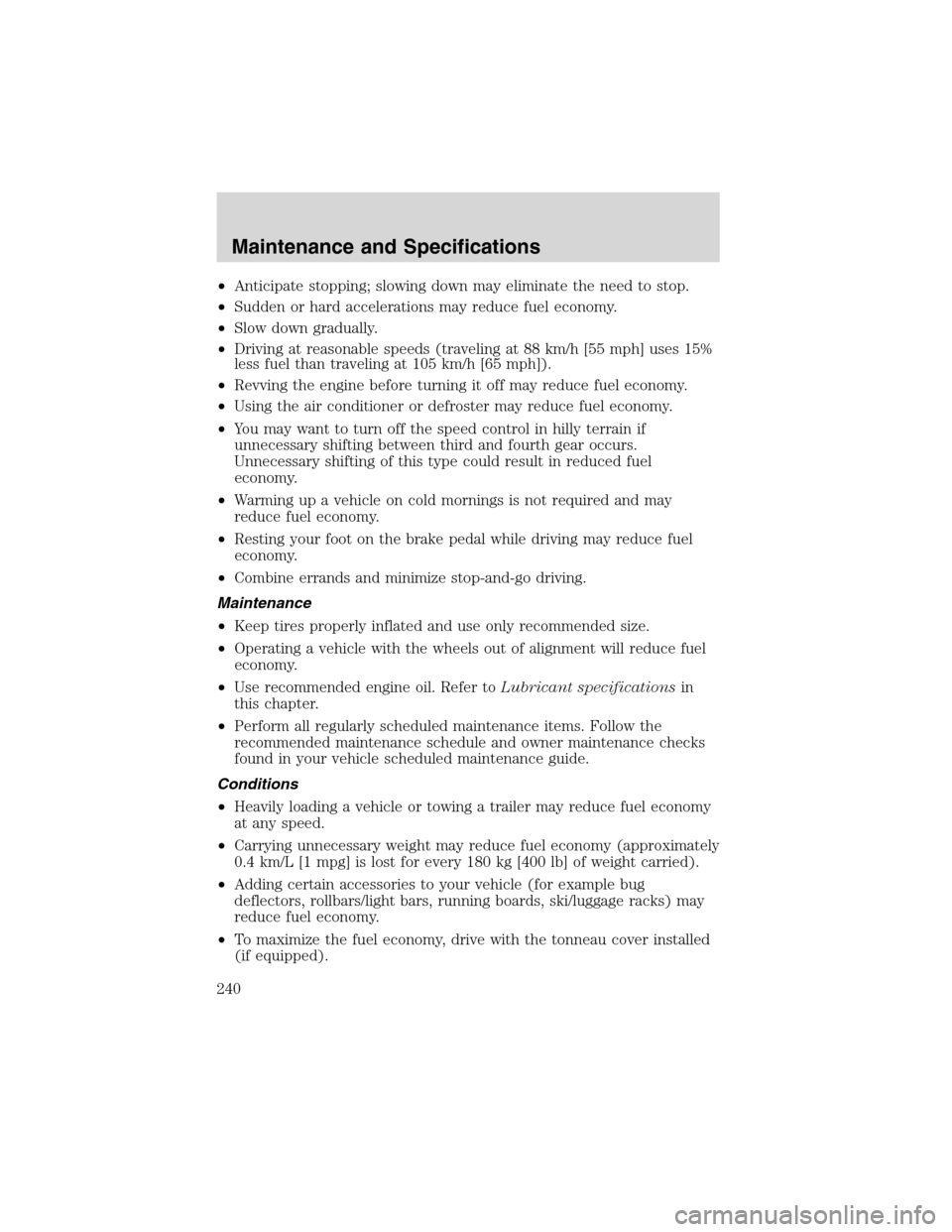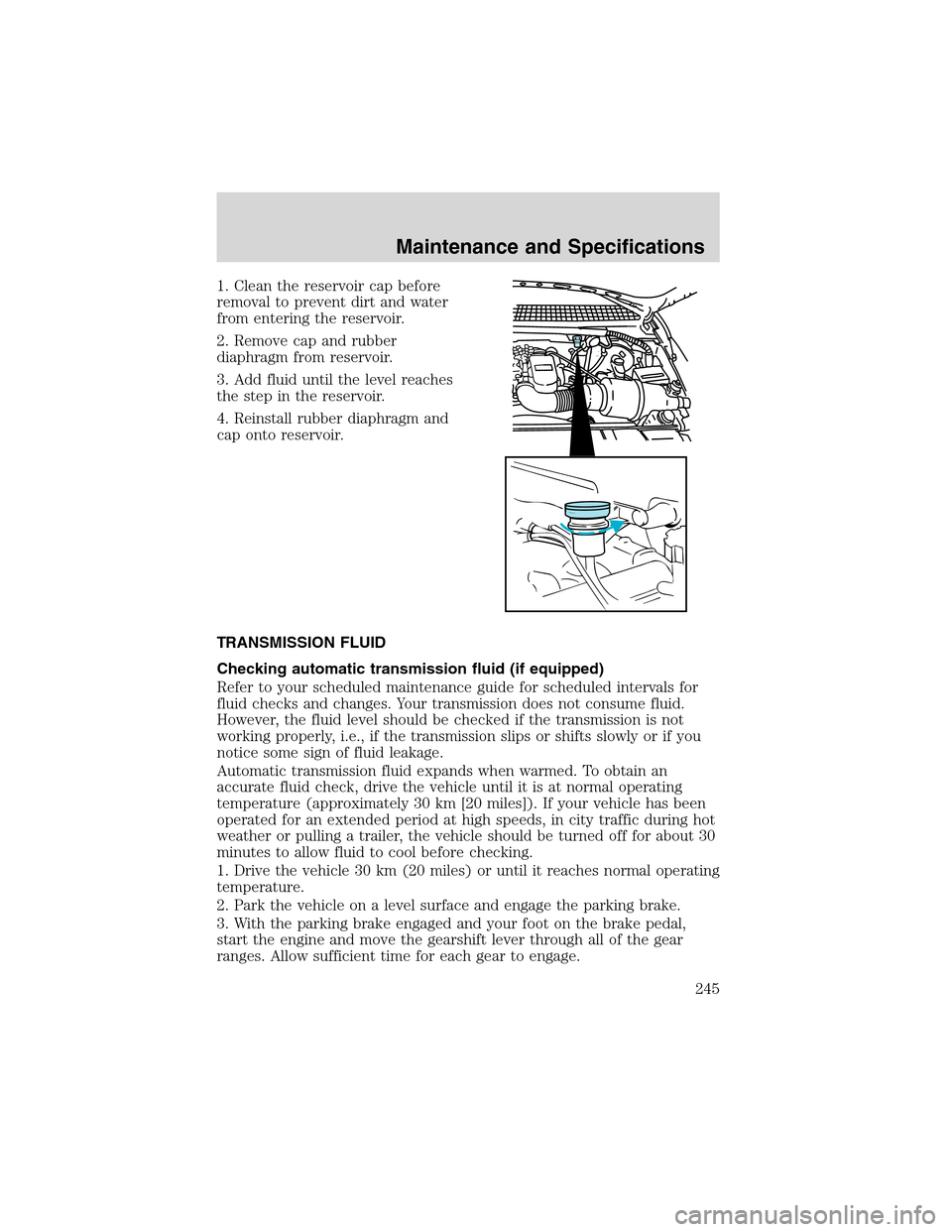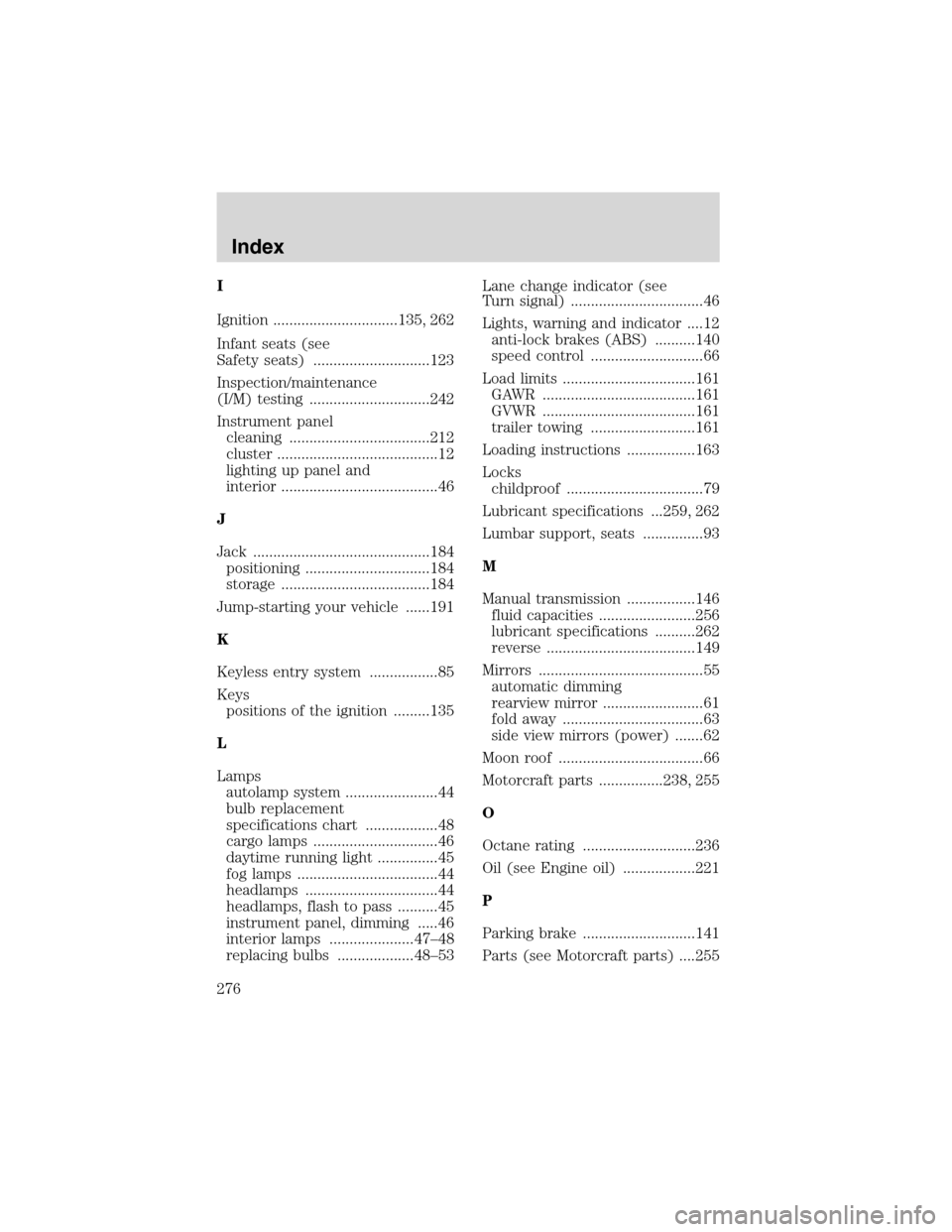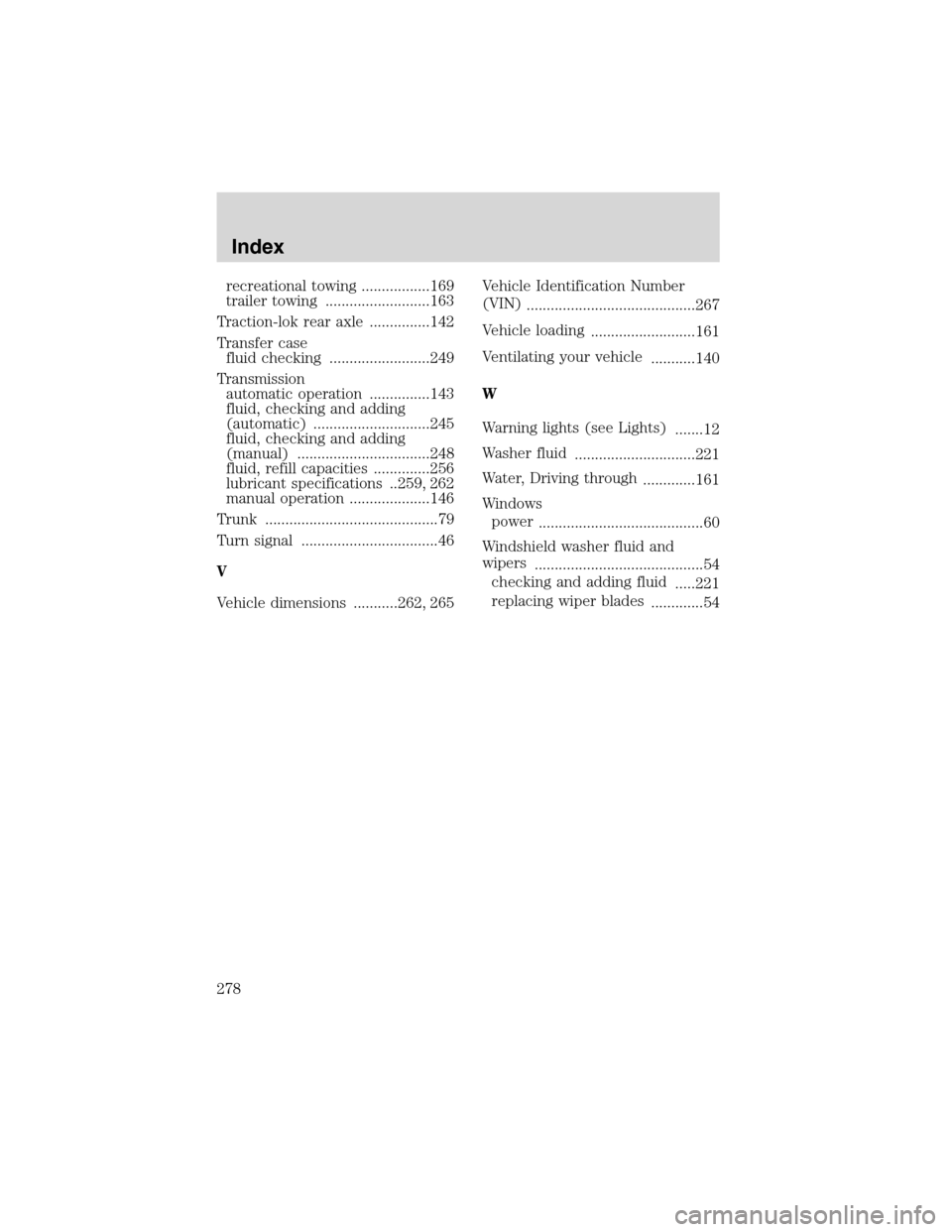Page 184 of 280

Fuse/Relay
LocationFuse Amp
RatingPower Distribution Box
Description
205—Horn relay
206—Fog lamp relay
207—Front washer pump relay
208—Intercooler pump relay
(supercharged engine only)
209—Front wiper HI/LO relay
301—Fuel pump relay
302—Trailer tow battery charge relay
303—Heated backlight relay
(SuperCrew only)
304—PCM relay
305—Fuel pump HI/LO relay
(supercharged engine only)
306—Inertia switch relay (supercharged
engine only)
401—Not used
501—PCM diode
502—A/C compressor diode
503—Not used
601 CB Power windows, Moonroof
(SuperCrew only)
602—Not used
*Mini fuses **Maxi fuses
CHANGING THE TIRES
If you get a flat tire while driving, do not apply the brake heavily.
Instead, gradually decrease your speed. Hold the steering wheel firmly
and slowly move to a safe place on the side of the road.
Harley-Davidson vehicles are equipped with a spare tire with a different
speed rating than the road tires. It is not recommended that you exceed
112 km/h (70 mph) when the spare tire is in use. Though the spare tire
is rated for 112 km/h (70 mph), always obey the local speed limits.
Roadside Emergencies
184
Page 240 of 280

•Anticipate stopping; slowing down may eliminate the need to stop.
•Sudden or hard accelerations may reduce fuel economy.
•Slow down gradually.
•Driving at reasonable speeds (traveling at 88 km/h [55 mph] uses 15%
less fuel than traveling at 105 km/h [65 mph]).
•Revving the engine before turning it off may reduce fuel economy.
•Using the air conditioner or defroster may reduce fuel economy.
•You may want to turn off the speed control in hilly terrain if
unnecessary shifting between third and fourth gear occurs.
Unnecessary shifting of this type could result in reduced fuel
economy.
•Warming up a vehicle on cold mornings is not required and may
reduce fuel economy.
•Resting your foot on the brake pedal while driving may reduce fuel
economy.
•Combine errands and minimize stop-and-go driving.
Maintenance
•Keep tires properly inflated and use only recommended size.
•Operating a vehicle with the wheels out of alignment will reduce fuel
economy.
•Use recommended engine oil. Refer toLubricant specificationsin
this chapter.
•Perform all regularly scheduled maintenance items. Follow the
recommended maintenance schedule and owner maintenance checks
found in your vehicle scheduled maintenance guide.
Conditions
•Heavily loading a vehicle or towing a trailer may reduce fuel economy
at any speed.
•Carrying unnecessary weight may reduce fuel economy (approximately
0.4 km/L [1 mpg] is lost for every 180 kg [400 lb] of weight carried).
•Adding certain accessories to your vehicle (for example bug
deflectors, rollbars/light bars, running boards, ski/luggage racks) may
reduce fuel economy.
•To maximize the fuel economy, drive with the tonneau cover installed
(if equipped).
Maintenance and Specifications
240
Page 245 of 280

1. Clean the reservoir cap before
removal to prevent dirt and water
from entering the reservoir.
2. Remove cap and rubber
diaphragm from reservoir.
3. Add fluid until the level reaches
the step in the reservoir.
4. Reinstall rubber diaphragm and
cap onto reservoir.
TRANSMISSION FLUID
Checking automatic transmission fluid (if equipped)
Refer to your scheduled maintenance guide for scheduled intervals for
fluid checks and changes. Your transmission does not consume fluid.
However, the fluid level should be checked if the transmission is not
working properly, i.e., if the transmission slips or shifts slowly or if you
notice some sign of fluid leakage.
Automatic transmission fluid expands when warmed. To obtain an
accurate fluid check, drive the vehicle until it is at normal operating
temperature (approximately 30 km [20 miles]). If your vehicle has been
operated for an extended period at high speeds, in city traffic during hot
weather or pulling a trailer, the vehicle should be turned off for about 30
minutes to allow fluid to cool before checking.
1. Drive the vehicle 30 km (20 miles) or until it reaches normal operating
temperature.
2. Park the vehicle on a level surface and engage the parking brake.
3. With the parking brake engaged and your foot on the brake pedal,
start the engine and move the gearshift lever through all of the gear
ranges. Allow sufficient time for each gear to engage.
Maintenance and Specifications
245
Page 270 of 280
Dash trim (wood grain)
Engine block heaters
Manual sliding rear window
Power sliding rear window
Remote start system
Tire step
Travel equipment
Cargo cage (SuperCrew only)
Bed mount bike carrier
Bed tent
Fog lights
Hitch mount bike carrier
Inside mirror with compass display
Inside mirror with compass and temperature display
Off road lights
Outside signal mirror (available only with power mirrors)
Pickup box rails
Retractable bed hooks
Running boards (molded, diamond plate, tubular and stirrup step)
Seatback organizer
Speed control
Towing mirrors
Trailer hitch (Class III)
Trailer hitch bars and balls
Trailer hitch wiring adaptor
Trailer swivel hitch
Protection and appearance equipment
Bed mat/bedliner tailgate covers
Bed mats
Bedliners
Bull bar (chrome & black)
Accessories
270
Page 276 of 280

I
Ignition ...............................135, 262
Infant seats (see
Safety seats) .............................123
Inspection/maintenance
(I/M) testing ..............................242
Instrument panel
cleaning ...................................212
cluster ........................................12
lighting up panel and
interior .......................................46
J
Jack ............................................184
positioning ...............................184
storage .....................................184
Jump-starting your vehicle ......191
K
Keyless entry system .................85
Keys
positions of the ignition .........135
L
Lamps
autolamp system .......................44
bulb replacement
specifications chart ..................48
cargo lamps ...............................46
daytime running light ...............45
fog lamps ...................................44
headlamps .................................44
headlamps, flash to pass ..........45
instrument panel, dimming .....46
interior lamps .....................47–48
replacing bulbs ...................48–53Lane change indicator (see
Turn signal) .................................46
Lights, warning and indicator ....12
anti-lock brakes (ABS) ..........140
speed control ............................66
Load limits .................................161
GAWR ......................................161
GVWR ......................................161
trailer towing ..........................161
Loading instructions .................163
Locks
childproof ..................................79
Lubricant specifications ...259, 262
Lumbar support, seats ...............93
M
Manual transmission .................146
fluid capacities ........................256
lubricant specifications ..........262
reverse .....................................149
Mirrors .........................................55
automatic dimming
rearview mirror .........................61
fold away ...................................63
side view mirrors (power) .......62
Moon roof ....................................66
Motorcraft parts ................238, 255
O
Octane rating ............................236
Oil (see Engine oil) ..................221
P
Parking brake ............................141
Parts (see Motorcraft parts) ....255
Index
276
Page 278 of 280

recreational towing .................169
trailer towing ..........................163
Traction-lok rear axle ...............142
Transfer case
fluid checking .........................249
Transmission
automatic operation ...............143
fluid, checking and adding
(automatic) .............................245
fluid, checking and adding
(manual) .................................248
fluid, refill capacities ..............256
lubricant specifications ..259, 262
manual operation ....................146
Trunk ...........................................79
Turn signal ..................................46
V
Vehicle dimensions ...........262, 265Vehicle Identification Number
(VIN)
..........................................267
Vehicle loading
..........................161
Ventilating your vehicle
...........140
W
Warning lights (see Lights)
.......12
Washer fluid
..............................221
Water, Driving through
.............161
Windows
power
.........................................60
Windshield washer fluid and
wipers
..........................................54
checking and adding fluid
.....221
replacing wiper blades
.............54
Index
278
Page:
< prev 1-8 9-16 17-24